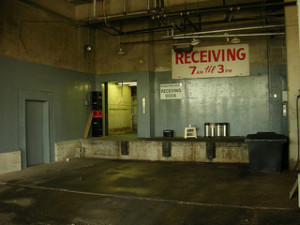Rodent poo, insects, fumes from plastic wrap, and moving forklifts are some of the hazards faced by workers who move materials in warehouses and trucks.

Photo credit: Ed Schipul on Flickr
This Shipping and Receiving bulletin from the Canadian Centre for Occupational Health and Safety categorizes the hazards into these six areas:
Biological – including molds, insects, and rodent droppings
Chemical – including plastic fumes from shrinkwrap and emissions from powered vehicles
Ergonomic – from standing, lifting, pulling, twisting, and bending
Physical – including heat, cold, and UV radiation
Safety – including work near moving equipment, conveyor belts, and working at heights
Psychological – including stress from shift work, extended work days, and pressure from “quick turnaround” demands and multitasking
One driver’s story
It was a link on Twitter, posted by CCOHS, that led me to the above info. To get more info, I followed up with the delivery driver who shared his story in my post Risks of working late night retail.
I told him about the six hazards listed above and asked what he and his colleagues do to guard against them. Here’s what he told me via email.
“Everybody at my work has taken a safe lifting course, but the fact of the matter is, sometimes the safest way to lift something just isn’t possible due to size, space constraints etc.” he wrote.
He also said that iPods are not allowed. Nor are cellphones, even hands-free.
Pedestrians walk on designated paths that keep them away from forklifts and other moving equipment.
All trucks must have two tires chocked to prevent roll-aways.
“As for safety at the dock itself, we use a dock lock restraining device that locks a trailer or truck to the building and prevents roll away accidents,” he said.
Then he described what he sees as the most important aspect of safety: “All in all, you can have every safety feature, and all the training in the world, but if people don’t take personal responsibility for their own safety, accidents will, and do happen.”
I agree that individual responsibility is an important part of safety, along with a look at systemic factors that affect safety at every level, right to senior management and company owners.



As an executive at a Canadian manufacturer of safety work gloves, I’m well aware of the importance of safety in the workplace. I enjoy all the posts on your blog, and applaud your efforts for bringing awareness to the importance of having a safety mindset on the job.
In this case the writer states that employees at his workplace weren’t allowed to carry phones, even while hands-free is enabled. In these situations, a dedicated worker safety monitoring device would be ideal. These types of devices allow emergencies to be detected instantly without the risk of an employee becoming distracted.
Disclaimer – I work for Blackline GPS, a company that designs and manufactures employee safety monitoring devices. (http://blacklinesafety.com/solutions)